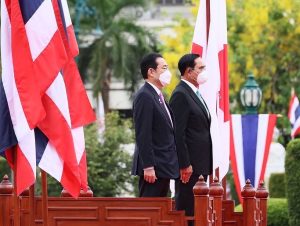Thailand and Japan have enjoyed over 600 years of friendly exchanges. Following the establishment of formal diplomatic relations in 1887, Thailand has never had any trouble with Japan apart from hiccups during the Second World War and the 1970s anti-Japan movement, which was motivated by trade imbalances and fears of Japanese economic invasion. The two nations have maintained close ties in all areas – economic, political, interpersonal contacts, and royal connections – except one: defense.
Given Japan’s postwar constitutional and normative constraints, and Thailand’s lack of external threat in the aftermath of the Indochina Wars, Thai-Japanese military engagement has traditionally been restricted to “peacekeeping” missions under the United Nations or United States alliance framework. Examples include the 1999 peacebuilding operations in East Timor (Japan was the biggest financial contributor while Thailand supplied the second largest number of troops to the U.N.-mandated International Force East Timor), reconstruction efforts in Afghanistan, and Japan’s participation in the U.S.-Thailand led Cobra Gold drill since 2005.
Over the last decade, however, both Bangkok and Tokyo have made critical adjustments to their defense postures in response to rising geopolitical uncertainties. Under the security-oriented Prayut Chan-o-cha government, Thailand has ramped up the procurement of high-end weapons, unveiled a 10-year modernization plan in 2017 to raise defense spending to 2 percent of GDP, and thrust technology transfer to the forefront of the country’s defense deals. The government’s immediate goal is to ensure that the Thai armed forces are readily equipped while the long-term goal is to establish a local defense industrial base, thereby reducing Thailand’s dependence on imported weapons and facilitating Thailand’s pursuit of neutrality in international relations.
Japan’s quest for remilitarization, meanwhile, has become more palpable. The ban on Japanese arms export has been lifted and the Japan Self-Defense Forces were recently permitted to fight overseas for the first time since WWII. Efforts have also been made to raise national security awareness and promote patriotic education among the Japanese public.
Under the Abe Shinzo government (2012-2020), Southeast Asia became very important in Japan’s strategic calculations. This trend has continued under the administrations of Suga Yoshihide (2020-2021) and Kishida Fumio (2021-present). This, on the one hand, highlights Japan’s attempt to play a more proactive role in the U.S.-Japan alliance by serving as a bridge connecting the reluctant ASEAN countries to the U.S. Yet, on the other hand, it reflects Japan’s attempt to hedge against the risks of U.S. abandonment.
In a clear departure from the long-cherished Yoshida Doctrine, which stresses economic development and entrusts security matters to the U.S., Japan has launched a series of independent defense initiatives with Southeast Asian nations. With Thailand, there have been frequent discussions between Thai and Japanese military officers, and Abe’s Japan was reportedly trying to win a contract to equip Thailand with an air defense radar system in 2016.
Still, Thailand’s defense cooperation with Japan has seen slower progress compared to other ASEAN nations. First, unlike Vietnam, Indonesia, the Philippines, and Malaysia, which share a “common enemy” – China – with Japan in the maritime arena, Thailand has maintained a low profile in disputed waters. Second, Thai military leaders view Chinese arms sales favorably. Chinese weapons systems may be less advanced than that of the U.S. and Japan, but Chinese arms are much cheaper and are decent enough in quality.
The distance between Thailand and Japan became clear when Suga succeeded Abe. Suga followed Abe’s tradition of choosing Southeast Asia, not the U.S., as the destination of his first overseas trip as premier. But, unlike Abe, Suga excluded Thailand from his itinerary and made stops at Vietnam and Indonesia to primarily discuss strategic concerns. On a related note, Japan has started shifting some of its production away from Thailand to Vietnam.
Vietnam, Indonesia, the Philippines, and Malaysia have all signed the “Defense Equipment and Technology Transfer Agreement” to deepen bilateral defense relations with Japan, and the fear of being left behind must have weighed considerably into Thailand’s decision to pursue such an agreement with Japan. Amid mounting domestic priorities and defense budget cuts for the fourth consecutive year, which has further diminished Thailand’s prospect of acquiring the long-stalled Chinese submarines, the Thai-Japanese defense transfer deal was signed and revealed during Kishida’s official visit to Bangkok earlier this month.
Against the backdrop of a rapidly deteriorating security environment, Japan will surely step up its defense presence in Southeast Asia, and Japan’s influence in the Thai military modernization program will inevitably grow. The dramatic decline in Russia’s arms sales to the region will further work in Japan’s favor. That said, how far Japan’s military cooperation with Thailand (and ASEAN as a whole) will go will largely depend on Japan’s ability to pursue its security objectives without seriously provoking China.

































